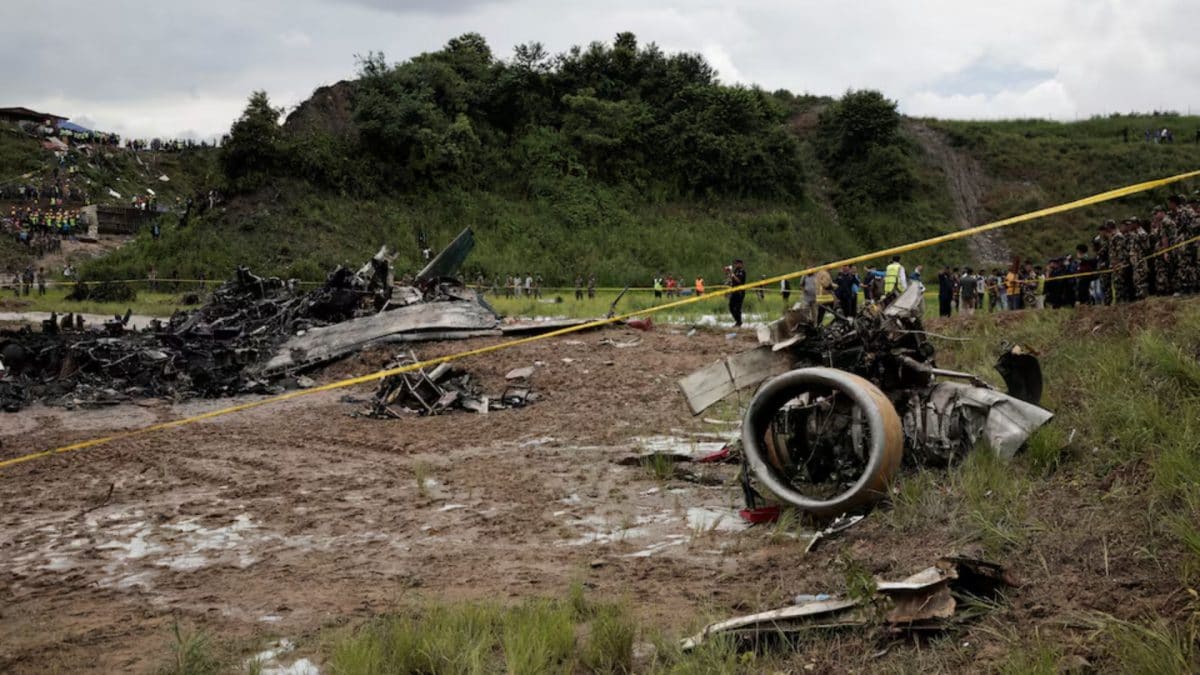Another year, another plane crash in Nepal. On Wednesday (July 24), 18 people died in a Saurya Airlines accident when the Pokhara-bound aircraft suffered a runaway excursion during takeoff from Kathmandu’s Tribhuvan International Airport. There were a total of 19 people, including two crew members, in the flight when it took off around 11 am on Wednesday to get its broken engine repaired at Pokhara, but only the pilot of the aircraft could be saved while all others have died.
Nepal is known for its picturesque landscape that lures tourists but the country’s air transport sector has been plagued by multiple accidents and crashes. Since 2000, as many as 360 people have been killed in Nepal in at least 19 air crashes. Wednesday’s crash at Kathmandu’s TIA has added to the long list.

Nepal and its bitter history of plane crashes On January 15, 2023, Nepal witnessed its worst aviation disaster since 1992 after a Yeti Airlines twin-engine ATR 72-500 aircraft which took off from Tribhuvan International Airport with 72 people, including four crew members, on board crashed on the Seti River gorge between the old and new airport in central city of Pokhara. For the unversed, in 1992, all 167 people aboard a Pakistan International Airlines (PIA) plane were killed when it ploughed into a hill as it tried to land in Kathmandu. Rescue officials could only manage to recover 71 bodies with the other missing passenger presumed to be dead.
Among those who were killed in the accident, five were Indians. Also Read: 18 dead as plane with ‘broken’ engine crashes during takeoff in Nepal’s Kathmandu As per the earlier reports the Yeti airplane had crashed just ‘10 to 20 seconds’ before landing. An analysis of the cockpit voice recorder and flight data recorder had shown the propellers of both engines went into “feather in the base leg of descending.
" However, in December last year, a government-appointed investigation panel revealed that the Yeti Airlines crash in 2023 was due to “pilot error”. Why are there so many plane crashes in Nepal? There are a host of reasons why flying in Nepal is not just tricky but dangerous. The top-most being the country’s topography.
Nepal, situated between India and China, boasts of having eight of the world’s 14 highest mountains, including Mt Everest, and the country’s beautiful rugged landscapes make it a popular tourist destination for trekkers. But as much as it is good for tourism, it is risky for airplanes. An earlier report by ANI quoted Captain Amit Singh, a commercial pilot and founder of Safety Matters Foundation, as saying that Kathmandu is a valley, it is like a bowl and the airport in the city is in between, surrounded by mountains, high mountains on all sides.
“So it is a very challenging airfield,” he added. Airports in the country are built in mountainous regions and therefore, have shorter runways. In 2019, Nepal’s civil aviation authority released a safety report where it admitted that the country’s “diversity of weather patterns together with hostile topography are the main challenges surrounding aircraft operations in Nepal due to which the number of accidents related to small aircraft.
.. seems comparatively higher”.
The take-off and landing statistically are more dangerous in Nepal than other parts of flight as it has to be done at high altitudes. The low air density decreases the performance of a flight and makes it more difficult to slow down. Not just this, Nepal also experiences sudden changes in weather.
Also, with odd weather conditions, visibility becomes a major hurdle for pilots flying in the region. Pilots, earlier, have even voiced concerns saying that the smaller aircraft used in the region aren’t equipped with the technology to detect the unpredictable conditions, making flying an even riskier proposition. Aging fleet Nepal, one of the poorer countries in the world, depends heavily on aging airplanes for its domestic flights.
Surprisingly, almost all of these aircrafts are not equipped with the mandatory modern devices including radar and GPS technology that can help mitigate problems with visibility or weather. The Yeti Airlines plane which crashed in January 2023 was 15 years old. Nepali airlines banned by EU Since 1960, Nepal has been a member of the UN’s International Civil Aviation Organisation (ICAO) which obliges the country to abide by the international conventions, regulations, standards, and recommended practices in aviation safety.
Despite making significant efforts to enhance safety, Nepal aviation industry’s safety record still does not match up with the requirements of other civil aviation authorities. Therefore, Nepali airlines have been banned from operating in the European Union’s airspace since 2013 and Nepal, till date, remains on the EU Air Safety list. A look at Nepal plane & helicopter crashes history July 24, 2024 At least 18 people were killed when a Bombardier CRJ 200 plane crashed and caught fire while taking off from Kathmandu.
July 11, 2023 Six people were killed in a helicopter crash in central Nepal. The chopper, which departed from Solukhunvhu district, home to Mount Everest and other high mountain peaks, had five Mexican nationals and one Nepali pilot on board. January 15, 2023 A twin-engine ATR 72 aircraft carrying 72 people, operated by Nepal’s Yeti Airlines, crashed in Pokhara, killing all on board.
May 29, 2022 Sixteen Nepalis, four Indians and two Germans died on a De Havilland Canada DHC-6-300 Twin Otter aircraft that crashed within 15 minutes after take off from Pokhara. February 27, 2019 All seven people, including the country’s tourism minister, on board a helicopter died after it crashed in bad weather in eastern Nepal. March 12, 2018 Fifty-one of 71 people on a Bangladeshi airliner operated by US-Bangla Airlines died when it crashed in cloudy weather as it came in to land at the Kathmandu airport.
February 26, 2016 Two people were feared dead after a small plane crashed in western Nepal’s Kalikot district. It was operated by Kasthamandap Airlines. February 24, 2016 A small plane, with 23 people on board, crashed in bad weather, killing everyone.
The Twin Otter aircraft, operated by Tara Air, was on a flight from Pokhara to Jomsom in western Nepal. February 16, 2014 All 18 people on a small plane that crashed in bad weather were killed. The Twin Otter aircraft was operated by state-run Nepal Airlines Corp.
September 28, 2012 A small propeller-driven Dornier aircraft struck a bird and crashed shortly after takeoff from Kathmandu, killing 19 people, including seven British and five Chinese passengers. September 25, 2011 A small plane carrying foreign tourists to view Mount Everest crashed in bad weather near Kathmandu, killing all 19 people on board. The Beech aircraft was operated by private airline Buddha Air.
December 16, 2010 A small plane crashed in the Himalayan foothills of remote east Nepal, killing all 22 people onboard. The Twin Otter aircraft was operated by Tara Air. August 24, 2010 Fourteen people - including four Americans, a Japanese and British national - were killed when their small plane crashed in bad weather in Nepal.
It was operated by privately held Agni Air. October 8, 2008 A small Twin Otter plane crashed in the remote mountains of northeast Nepal, killing at least 18 people, mostly foreigners. March 4, 2008 Four UN arms monitors were among at least 10 people killed in a helicopter crash in Nepal.
June 21, 2006 A Twin Otter passenger plane operated by Yeti Airlines crashed minutes before landing in the west of the country, killing all nine people on board. May 25, 2004 A Twin Otter cargo plane crashed in the Mount Everest region, killing its three crew. It was operated by Yeti Airlines.
August 22, 2002 Another Twin Otter plane, carrying foreign tourists, slammed into a mountain in bad weather in Nepal, killing all 18 people on board. It was operated by Shangrila Air. July 17, 2002 Four people were feared dead after a twin-engined aircraft crashed into a mountain in west Nepal minutes before it was due to land.
July 27, 2000 A Canadian-built Twin Otter passenger plane crashed in western Nepal, killing all 25 people on board. It was operated by state-owned Royal Nepal Airlines. With inputs from agencies.



















